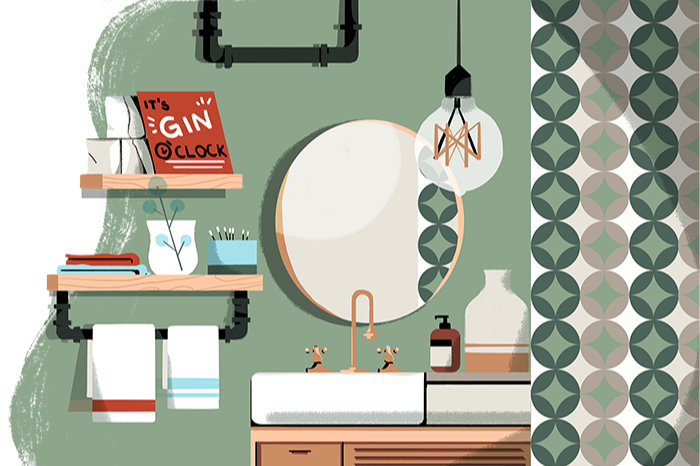The curse of the Airbnb aesthetic
Why are we traveling? And would we still travel if it was the same everywhere? What would be the goal?
Surf on Airbnb looking for your next vacation apartment and you’ll notice that the deals in New York or Paris, London or Budapest, São Paulo or Tokyo often look strangely similar. As others have pointed out, it’s as if a tasteful veil of white walls and gray sofas, houseplants and Mid-Century style furniture has come down and flattened them all into one uniformity. . Writer Kyle Chayka has dubbed this phenomenon the continued commendable indoor “airspace”.
There can be a few deliberately quirky touches (because short-term rental design guides tell hosts people love quirky touches, within reason). These express individuality and character in the same way that someone who has an “independent thinker” on their social media profile will never be that deeply unoriginal and conformist.
There could be a characteristic wall, standing out for its ominous pattern. There could be an inspirational message in big faux driftwood letters in the kitchen. “To live, to love, to laugh” always seems particularly profound to me. Or it could be written on a bulletin board in restaurant-style lettering, perhaps spelling out “But first, coffee.”
© Illustrations: Giulia Giovannini
The gracious host may have left a recipe for lemonade on a blackboard or the addresses of a few cafes that look exactly like the cafes in the town you just left and where the baristas have the same beards and tattoos and the coffee is the same. small Duralex glasses.
There may be a row of golden gnomes or an antique car model that isn’t quite a toy. There will be houseplants everywhere, including some falling from a small wooden shelf with black brackets and a small terrarium on it. These are for Instagramming. These are Instants.
Because these interiors are designed to be consumed like images on a screen. They are designed to appeal with an idea of generic overall familiarity. They represent a metropolitan, chic, minimal and self-congratulating lifestyle. You like the picture because that’s how you imagine you might want to live. You already recognize it. What is happening here is some hateful digital aesthetic infiltration, an unintended effect of the gradual global convergence of the interior. There is an irony to this because Airbnb sowed the seeds of authenticity. The trick was to disrupt the hospitality industry by allowing travelers (never tourists) to temporarily fit into the homes of real people in real neighborhoods where real people live (as if hotels were inevitably located in places unreal).
But authenticity comes with difference. Fun-sized beds, old furniture, clutter, mothballs, unequipped Victorian wardrobes, stains, the accumulated stuff of a lifetime. It turned out that it wasn’t a seductive look. People like their difference to be generic. They want something a little prettier than these bedroom sets at Ikea. They want something like the nicest, most minimalist apartments on Airbnb.
This is not to blame the digital platform. She proclaims herself a stakeholder in the sharing economy and, in the process, she shared the gaze. We scroll and make decisions, we are all more than accomplices. Airbnb has become an improbable design style-book, an endless scattered network of interiors.
Once, people would watch the movies, see the sets, and try to emulate the Hollywood style through local versions available in stores in their hometowns. Then they bought some DIY magazines and upgraded their homes with flush doors and tiered plant racks. Then they flipped through interior magazines for tips on urban cool. Then, they idled in traffic while waiting to visit the big blue boxes on the industrial outskirts of cities to find inspiration in the bedroom sets.
© Giulia Giovannini
Now we don’t even have to buy a magazine anymore: we can mindlessly browse slightly overpriced apartments on Airbnb, and the look is seeping in. Where once we bought a guide and phoned a few retirement to book a room over the phone (which took, maybe, half an hour), now we’re endlessly surfing through strangely familiar apartments, unable to decide because they all look alike.
If time is money, we’ve become ridiculous fools trying to save a few pounds while spending priceless, sunk hours. These apartments, this style, this distinctive banality infiltrates our consciousness and it becomes, paradoxically, an aspiration.
The irony is that in seeking a trip, a change of scenery, we have found anonymity repackaged as cool and now we aspire at home to the inevitable of a reimported world banality. Builders and developers are now building for Airbnb. There are whole blocks of generic apartments that move smaller, more original and interesting buildings into the dense complexity of neighborhoods, with their social and business mix aimed at short-term tenants and higher margins for investors.
Other buildings are emptied, their interiors turned into cloned versions of online photos, as if an algorithm has flattened and photoshopped the differences and regurgitated them IRL.
© Giulia Giovannini
If you look at interactive renderings and interior projections where, say, you can place a sofa or kitchen to see what it would look like, they inevitably have digital flatness, crushing the grain and texture of reality. It is these high profile interiors that are now being reproduced. The painted floors are scuffed but in a good way the decorations are new but washed out like a 1950s photo, the sofa is a mid-century faux, the dining area and Eames faux chairs, the worktop made for look like it was recycled from a lab despite being artificially made and scuffed in India.
It’s like buying used jeans. And just as worn jeans are labor intensive and waste huge amounts of resources, the ‘air washing’ of interiors in which the old is discarded and the new is introduced – MDF, Chinese chipboard, Vietnamese self-assembly, fake Asian furniture, all shipped from around the world while local manufacturers are forced to leave industrial buildings and workshops as they are turned into industrial-chic lofts for tourists so Budapest can look a bit more like Brooklyn.
Even the credits, however, come into the classes. There’s the unwavering anemia of the new Airbnb build, but there’s also a bunch of designers who have set themselves up to cater to potential owners. They are able to replicate the look anywhere for anyone. The web is full of interior designers advertising their services to homeowners, and Airbnb’s own designers advise on the site.
The high-end look is just as easily identifiable as the more generic version: a few Portuguese ceramic tiles with 1970s or Islamic-inspired motifs, flea-market art clustered on the walls, flowers in a decanter, a mustard or pink velvet sofa in place of gray in cheaper apartments, the immediately noticeable feel of new-vintage decorative art suddenly bought in bulk rather than accumulated over time. There are walls and courtyards full of subtropical plants, subway tiles, murals, and breakfast bars with chrome fixtures and brightly colored Spanish fish boxes. The bathrooms have black or copper pipes and Aesop containers to complement the potted plants (the Aesop containers will be empty by the way).
House and house unlocked
FT subscribers can sign up for our weekly email newsletter featuring guides to the global real estate market, distinctive architecture, interior design and gardens. Register here in one click
A more extreme version can be seen in WeWork’s overly harsh interiors, where every boardroom has to be a little different, alternating geometric wallpaper, pressed pewter ceilings, tall Buddhas, vintage coat racks, faux old 1970s-folk armchairs . And in this way, the global landscape of short-term rentals, cafes, bars and workplaces merges into an endless online panorama of harmless snapshots.
The biggest irony is that roommate sites have reduced the living spectrum down to a few instantly recognizable and easily reproducible tropes and mean aspiration. We scroll through these images on Airbnb or Instagram and we, albeit subconsciously, absorb them. It becomes orthodoxy. We aspire to escape and travel, to a different city, to new experiences and we ended up remaking the world in a continuous landscape of comfortable banality. The more we are free to roam, the more we navigate; the more we yearn for change, the more we have made sure that everything becomes the same.
Edwin Heathcote is the architecture critic of the FT
To follow @FTProperty on Twitter or @ft_houseandhome on Instagram to first discover our latest stories
Letters in response to this article:
Being carpet bombarded with blandness on both sides / By Marie Louise von Glinski, Astoria, NY, US
Travelers find more comfort in the surroundings of the hosts than in the comments of the guests / By Jonathan Beyer, Bad Kreuznach, Germany




Comments are closed.